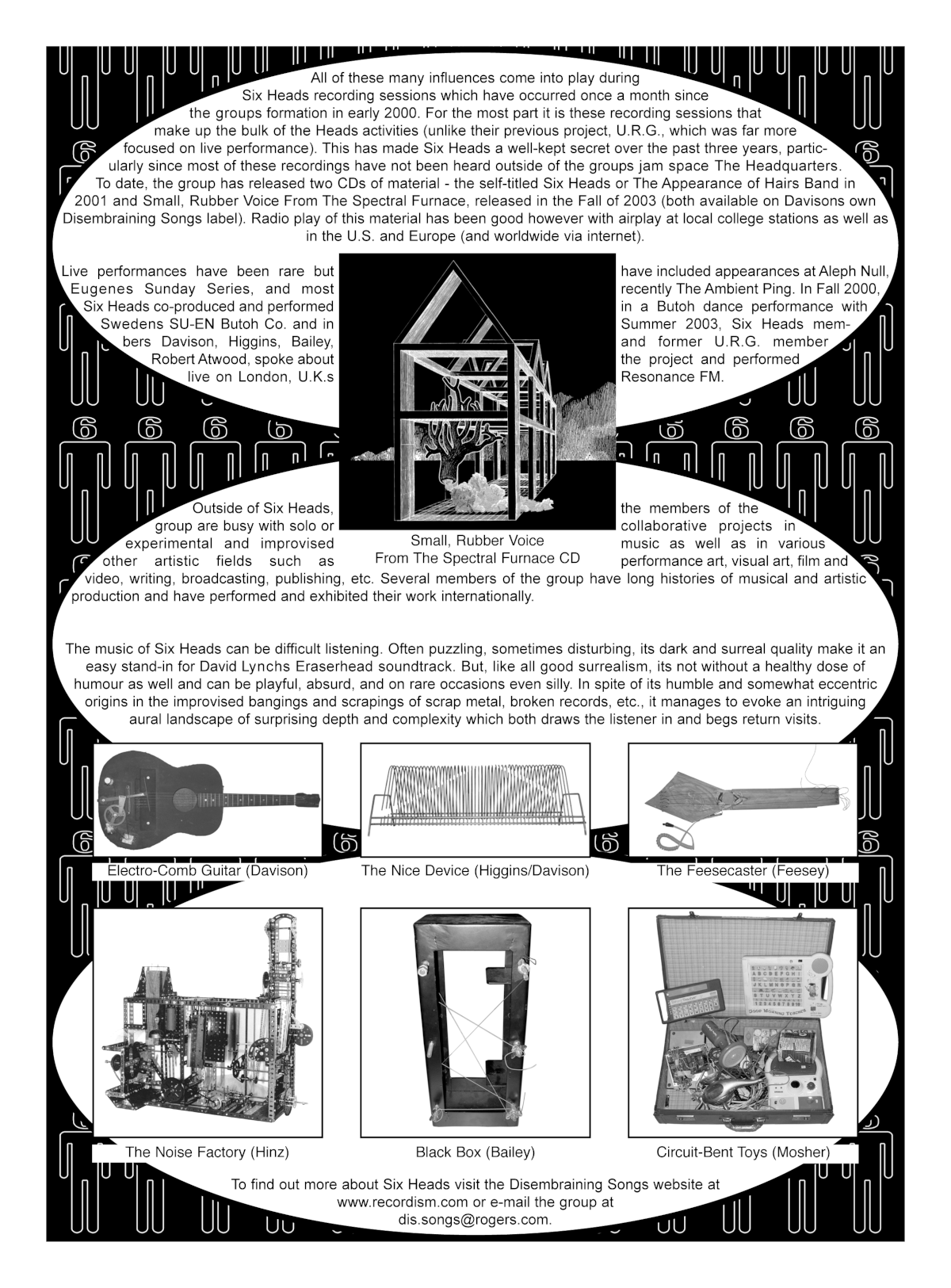Six Heads article which appeared in Magizone #2 (winter 2004 issue) published by Music Gallery Institute, Toronto.


Musique Concretins or The Sound of Six Heads Scratching
From the ridiculous to the sublime, but mostly just the ridiculous, Toronto's free-improv, absurdist/surrealist sound ensemble Six Heads, a.k.a. The Burning of Bridges Band, The Draining of Bogs Band, The Stuffing of Sausages Band, The Blinding of Mice Band, etc., meld and manipulate a vast assortment of audio elements, creating dense collages of concrete noise and disturbing more than just air molecules.At the beginning of 2000, several founding members and other key players of the defunct Urban Refuse Group (a Toronto-based improvised noise/junk instrument collective which ran from 1996 to 2000) began to rework the fundamental principles of their group, extracting and expanding upon some of their previous project's best ideas and adding a few new twists as well, resulting in the abstruse yet aptly named Six Heads.
Six Heads employs a wide-ranging and unconventional instrumentation including hand-built instruments, toys and found objects, circuit-bent electronics, field recordings, vinyl LPs, and other pre-recorded material, conventional instruments played in unconventional ways, and so on. In addition to the extensive use of free-improvisation or spontaneous composition (with occasional forays into chance and game processes), the group further shapes their sound through creative live mixing and audio processing. With the combination of these essential elements and approaches, Six Heads members James Bailey, William Davison, Linda Feesey, Sherri Lyn Higgins, Colin Hinz, and Pete Mosher invent their own form of audio surrealism, crafting unique auditory assemblages that exist in the hazy borders between music and sound art. From their improvisations emerges a kind of spontaneous, free-form musique concrete resembling dense, shifting sonic dreamscapes with layers of ambient textures and jarring juxtapositions of concrete sound (machine noises, voices, fragments of music, and other sounds less identifiable).
In a recent gathering, members of Six Heads discussed various aspects of the project, revealing details which help shed light on the group's unique, perhaps peculiar, qualities. For instance, they revealed without hesitation, either a complete lack of musical training or an early rejection of it. As well, each member spoke of a strong desire - for most, formed at any early age - to explore less conventional types of music and to become involved in various kinds of audio experimentation.
Influences from punk and industrial music were cited, such as Throbbing Gristle, Psychic TV, Nurse With Wound, Zoviet France, The Residents, Negativland, The Nihilist Spasm Band, etc. (inspirations one might easily suspect upon listening to the music of Six Heads) but the complete range of audio influences on the various members of the group is quite vast - everything from avant-garde jazz and classical, prog rock, psychedelia, exotica, easy listening, ambient, electroacoustic, electronic, improvised and world music to spoken word, children's records, novelty songs, soundtracks, field recordings, etc. Not to mention each member's own individual sound experiments.
All of these many influences come into play during Six Heads recording sessions which have occured once a month since the group's formation in early 2000. For the most part it is these recording sessions that make up the bulk of the Heads' activities (unlike their previous project, U.R.G., which was far more focused on live performance). This has made Six Heads a well-kept secret over the past three years, particularly since most of these recordings have not been heard outside of the group's jam space "The Headquarters". To date, the group has released two CDs of material - the self-titled "Six Heads or The Appearance of Hairs Band" in 2001 and "Small, Rubber Voice from The Spectral Furnace", released in the Fall of 2003 (both available on Davison's own Disembraining Songs label). Radio play of this material has been good however with airplay at local college stations as well as in the U.S. and Europe (and worldwide via internet).
Live performances have been rare but have included appearances at Aleph Null, Eugene's Sunday Series, and most recently The Ambient Ping. In Fall 2000, Six Heads co-produced and performed in a Butoh dance performance with Sweden's SU-EN Butoh Co. and in summer 2003, Six Heads members Davison, Higgins, Bailey and former U.R.G. member Robert Atwood, spoke about the project and performed live on London, U.K.'s Resonance FM.
Outside of Six Heads, the members of the group are busy with solo or collaborative projects in experimental and improvised music as well as in other artistic fields such as performance art, visual art, film and video, writing, broadcasting, publishing, etc. Several members of the group have long histories of musical and artistic production and have performed and exhibited their work internationally.
The music of Six Heads can be difficult listening. Often puzzling, sometimes disturbing, it's dark and surreal quality make it an easy stand-in for David Lynch's "Eraserhead" soundtrack. But, like all good surrealism, it's not without a healthy dose of humour as well and can be playful, absurd, and on rare occasions even silly. In spite of its humble and somewhat eccentric origins in the improvised bangings and scrapings of scrap metal, broken records, etc., it manages to evoke an intriguing aural landscape of surprising depth and complexity which both draws the listener in and begs return visits. To find out more about Six Heads visit the Disembraining Songs website at www.recordism.com or e-mail the group dis.songs@rogers.com.